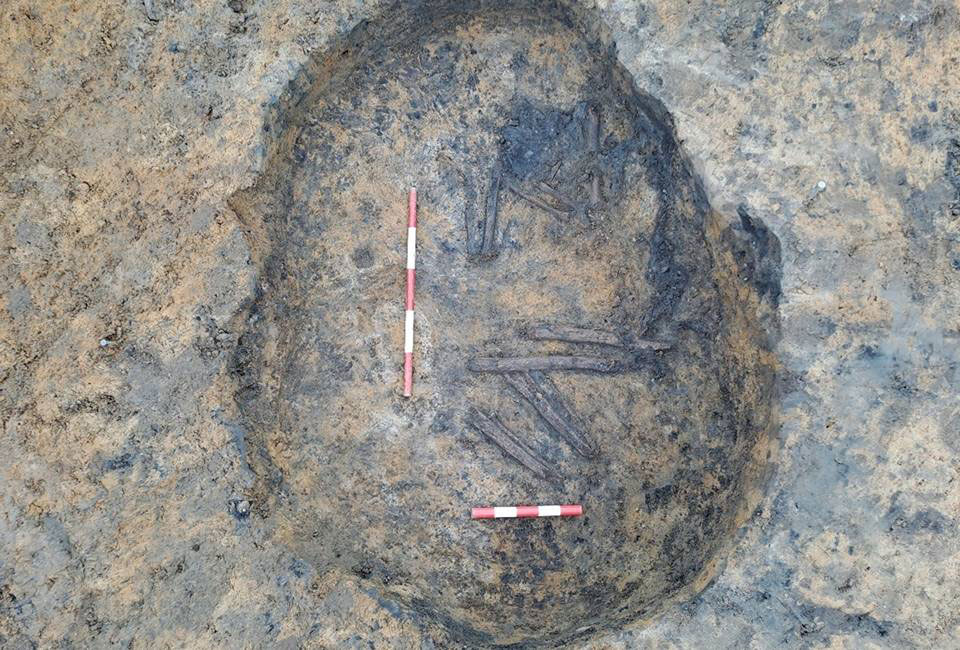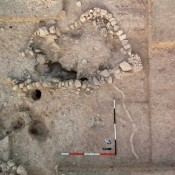A burial monument, burnt mound and parts of a Roman road have been discovered during investigations associated with the construction of a new Yorkshire Water sewer near Full Sutton.
Archaeologists working on the site before the new sewer was laid discovered three new sites that have provided exciting glimpses into the prehistoric and early historic past of the local area.
The investigations were carried out by Ecus Archaeology for Yorkshire Water during a £5m project to build a new 5.2km sewer and although several other areas of archaeology were expected and recorded as part of the project, the analysis of the new sites will provide important new data. The analysis stage of the project has not started yet, but it is clear that the recorded remains and the palaeoenvironmental material recovered have the potential to help answer some of the many remaining questions about life some four and a half thousand years ago.
The first site was a small circular burial monument discovered in the vicinity of Full Sutton. It was disturbed by later ploughing, but, considering the ground conditions, the associated human remains were surprisingly well-preserved. The local sandy geology is usually too acidic for human remains to survive, however, the grave had been backfilled with a mixture of burnt stone and charcoal from the adjacent ‘burnt mound’ spread, which seems to have help the bones survive.
The buried individual was placed in a pit in a foetal or ‘crouched’ position and this grave was surrounded by a ring-gully. These prehistoric traditions are known from similar monuments, or ‘round barrows’, discovered both in Yorkshire and throughout the UK. Such monuments are usually of a Later Neolithic or earlier Bronze Age date and were covered by a dome-shaped mound of earth or stone. This evidence tells us that the Full Sutton example could be approximately 4500 years old.
The grave did not contain any artefacts, however, the bones themselves are an important scientific resource as specialist analysis often provides evidence that can provide insights about the life of the individual.
Interestingly, the round barrow was constructed very close to, but not over, what archaeologists call a ‘burnt mound’. These enigmatic prehistoric sites are relatively common in upland areas where they survive as mounds of burnt stone and charcoal, but the lowland examples are less obvious due to being flattened by later ploughing. Little is known about what burnt mounds were used for, and their excavation is seen as an important research priority.
Adam Ellis, project manager at Yorkshire Water, said: “This has been a fascinating project to be involved with. The archaeology work prior to us starting the new sewer in the area is something we do on projects considered areas of archaeological interest and it was great to see some of the findings from site.
“Our project is now underway and the sewer currently being laid will provide services for the new prison.”
Previous excavations of similar sites in the UK and Ireland have shown that water was an important part of the process with water troughs lined with wood or clay being discovered. Other sites include earth-ovens or roasting pits and the combined evidence has led to several theories about what activities were carried out. The main theory is that stones were heated up and placed in the troughs to heat water, either during the process of dyeing cloth or cooking. Alternatively, some burnt mound sites include structures that could have been used as saunas.
Many questions remain, including did such sites have a variety of uses, and the Full Sutton evidence could provide some important clues. Associated with the remnants of the mound were a small earth oven as well as a deep pit that appeared to have been a well.
The earth oven still contained the stone from its last use and soil samples taken from its fills could, once analysed, provide clues as to what it was used for. The most exciting discovery, however, was that the lower part of the well was below the water table and this waterlogging had helped preserve part of its wooden lining.
In addition, the lower fills of the well were similarly waterlogged and the soil samples taken from these will probably contain the preserved remains of plants and possibly insects. Analysis of these will provide valuable and rare data about what was happening at the burnt mound site as well as what the local environment was like.
The final unexpected site was closer to Stamford Bridge where part of the foundations of a previously unknown Roman Road were revealed. The road foundation was flanked by drainage ditches and its alignment suggested it led northwards towards the Scheduled remains of the Roman town of ‘Derventio’ at Reckondales.
Although not as important as the prehistoric discoveries, the location and direction of this road, when combined with the other evidence recorded during the project in the Reckondales area, will help gain a better understanding of the Roman forerunner to Stamford Bridge.





